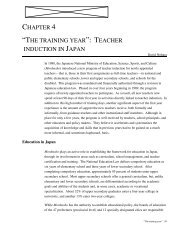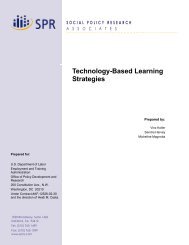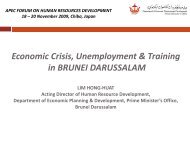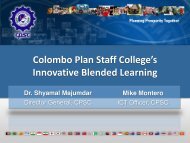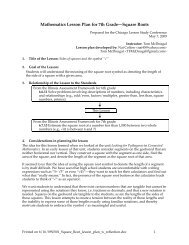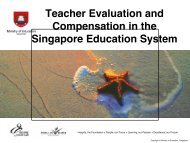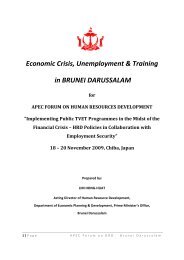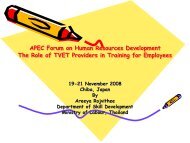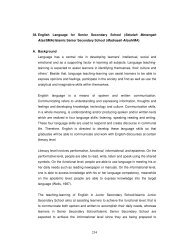Quality Assurance Systems in Asia-Pacific Economic Cooperation
Quality Assurance Systems in Asia-Pacific Economic Cooperation
Quality Assurance Systems in Asia-Pacific Economic Cooperation
Create successful ePaper yourself
Turn your PDF publications into a flip-book with our unique Google optimized e-Paper software.
ENHANCEMENT OF QUALITY ASSURANCE SYSTEMS IN HIGHER EDUCATION IN APEC MEMBER ECONOMIES<br />
4. Internal QA Processes<br />
All quality assurance practices of the APEC region emphasise and recognise the value of an<br />
analytical and self critical process be<strong>in</strong>g undertaken by those who undergo the external QA<br />
process. The published materials and the web sites regard<strong>in</strong>g the QA <strong>in</strong>itiatives of the region<br />
<strong>in</strong>dicate that a number of terms are frequently used to refer to similar phenomena, e.g. selfstudy,<br />
self-evaluation, self-analysis, self-assessment and Performance Portfolio. The term<br />
self-assessment is used <strong>in</strong> this report.<br />
4.1 Preparation of Self-assessment Report by the<br />
Institution/Program<br />
Usually, a set of standards and criteria, pre-determ<strong>in</strong>ed by the quality assurance system,<br />
forms the basis for the self-assessment report. There are generally national consultations to<br />
ensure wide participation of the stakeholders <strong>in</strong> evolv<strong>in</strong>g the standards and criteria. The<br />
<strong>in</strong>stitution (or program) undergo<strong>in</strong>g the process is asked to do a self-assessment and report<br />
on how it meets the standards set or criteria identified for the quality assurance procedure.<br />
The level of detail and analysis provided by the <strong>in</strong>stitution/program vary. Some systems<br />
require <strong>in</strong>stitutions to provide only basic data and <strong>in</strong>formation regard<strong>in</strong>g each of the standards<br />
or criteria, with marg<strong>in</strong>al expectations on the ‘assessment‘ part of the report. Others require a<br />
more evaluative or analytic report. The QA systems of the region recognise that capacity to<br />
prepare an evaluative report is the desirable stage <strong>in</strong> the development of quality assurance<br />
capacity among <strong>in</strong>stitutions. The underly<strong>in</strong>g assumption <strong>in</strong> <strong>in</strong>sist<strong>in</strong>g on the self-assessment is<br />
that an <strong>in</strong>stitution that really understands itself—its strengths and weaknesses, its potentials<br />
and limitations—is likely to be more successful <strong>in</strong> carry<strong>in</strong>g out its educational mission and<br />
more committed to address<strong>in</strong>g shortcom<strong>in</strong>gs revealed than one without such self-awareness.<br />
The survey <strong>in</strong>dicates that the QA systems guide HEIs to prepare a mean<strong>in</strong>gful selfassessment<br />
report and the level of guidance varies. This is <strong>in</strong> recognition that a thorough<br />
quality assurance exercise needs a good set of <strong>in</strong>formation on the pre-determ<strong>in</strong>ed criteria and<br />
standards to susta<strong>in</strong> quality judgments. This may pose a significant new challenge to HEIs<br />
(even to the ‘good’ ones), especially <strong>in</strong> the <strong>in</strong>itial phase of <strong>in</strong>troduc<strong>in</strong>g external quality<br />
assurance <strong>in</strong> a system. Over a period of time HEIs might have developed report<strong>in</strong>g systems<br />
for other purposes which may be totally different from what the self-assessment process<br />
requires. If HEIs are not helped to develop their capacity for conduct<strong>in</strong>g the self-assessment<br />
process, and for report<strong>in</strong>g that process <strong>in</strong> a way that will facilitate the QA exercise, it might<br />
result <strong>in</strong> <strong>in</strong>complete/<strong>in</strong>sufficient report<strong>in</strong>g. Realis<strong>in</strong>g this, the quality assurance bodies of the<br />
region provide guidel<strong>in</strong>es to facilitate the HEIs <strong>in</strong> the self-assessment process. There are<br />
considerable differences <strong>in</strong> the level of detail of the guidel<strong>in</strong>es, however.<br />
Most quality assurance systems provide guidel<strong>in</strong>es about what is expected of a selfassessment<br />
report and help HEIs appreciate the spirit of <strong>in</strong>trospection. Some quality<br />
assurance systems provide only brief guidel<strong>in</strong>es as to how the self-assessment report could<br />
be organised and how to present themselves with<strong>in</strong> the broad framework given by the quality<br />
assurance agency. However, when HEIs must adhere to more specific criteria, detailed<br />
guidel<strong>in</strong>es and manuals that <strong>in</strong>clude a list of questions to be answered and tables to be<br />
presented with data <strong>in</strong> a particular way, are developed. Such specific formats can be centred<br />
on quantitative data. In this approach, one added bonus for <strong>in</strong>stitutions is that it could help<br />
them to develop <strong>in</strong>formation systems, which may be used not only for support<strong>in</strong>g selfassessment<br />
but also for management and <strong>in</strong>stitutional decision-mak<strong>in</strong>g. Brunei, Chile, Hong<br />
Kong, Japan, Philipp<strong>in</strong>es and Vietnam have QA <strong>in</strong>itiatives that require the <strong>in</strong>stitutions to fill up<br />
pre-structured formats.<br />
Some systems offer a lot of flexibility to design their self-assessment and the consequent<br />
report. Partly <strong>in</strong> response to the grow<strong>in</strong>g diversity of <strong>in</strong>stitutions, and partly also <strong>in</strong> response to<br />
compla<strong>in</strong>ts from <strong>in</strong>stitutions about the burden of repeated accreditation visits, some regional<br />
accredit<strong>in</strong>g agencies <strong>in</strong> the US offer different options for how a self-study could be conducted.<br />
For example, the Middle States Commission on Higher Education has four major models for<br />
self-study: Basic Comprehensive, Comprehensive with Emphasis, Selected Topics and<br />
14



